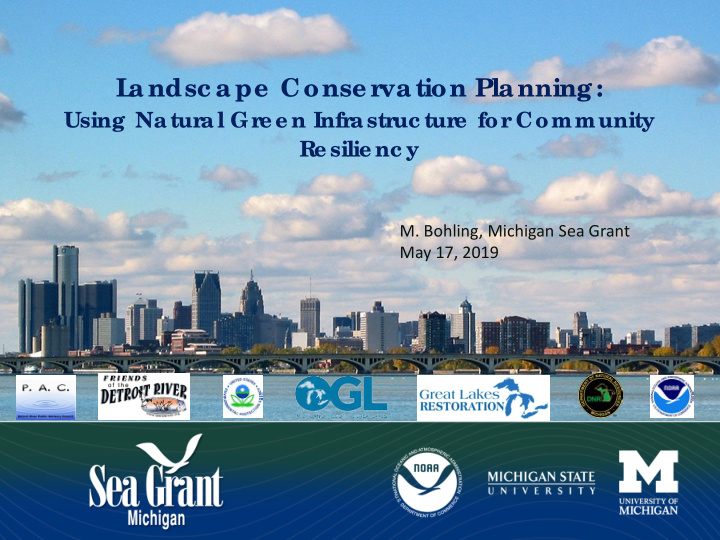



L a ndsc a pe Conse r va tion Pla nning : Using Natural Gre e n Infrastruc ture for Community Re silie nc y Safe & Sustainable Seafood M. Bohling, Michigan Sea Grant May 17, 2019
SEMCOG Definition of Green Infrastructure: Green infrastructure includes two broad categories: natural (undistributed environments such as wetlands, trees, prairies, lakes, rivers and streams) and constructed or built green infrastructure (such as rain gardens, bioswales, community gardens, and agricultural lands).
Channelization of the Detroit River – Livingston Channel From 1874 to 1968, 60 miles of shipping channels were excavated in the Detroit River.
Combined Sewer Overflow More than 25% of this region has combined sewers.
“The beach is perfectly safe for children. Although the water is somewhat polluted due to the beach being below city sewers, nothing is to be feared unless the water is swallowed” – Dr. Fred Adams, Medical Officer of Health, 1923
Industrial Pollution The Rouge River is one of 3 Great Lakes tributaries to catch on fire – late 1960s.
Oil saturated water In 1948, oil-soaked waterfowl carcasses were delivered to the steps of Michigan’s Capitol in protest of lethal oil pollution in the Detroit River. Events like this led to the 1972 Clean Water Act with a lofty goal of "zero discharge" of pollutants into the nation's waters by 1985. The EPA was given authority to implement these acts as well.
Wetland Losses May 1, 2019 May 8, 2019
The Detroit River is an: Area of Concern (AOC) Per 1987 amendments to the Great Lakes Water Quality Agreement between the U. S. and Canada.
14 possible Beneficial Use Impairments (BUIs) 11 were originally identified for the Detroit River: 1. Restrictions on fish and wildlife consumption 2. Tainting of fish and wildlife flavor – REMOVED 2013 3. Degradation of fish and wildlife populations 4. Fish tumors or other deformities 5. Bird and animal deformities or reproductive problems 6. Degradation of benthos 7. Restrictions on dredging activities 8. Eutrophication or undesirable algae –Never Impaired 9. Restrictions on drinking water consumption or taste and odor problems – REMOVED 2011 10.Beach closings 11.Degradation of aesthetic 12.Added costs to agriculture or industry – Never Impaired 13.Degradation of phytoplankton and zooplankton populations – Never Impaired 14.Loss of fish and wildlife habitat
A guidance document for removing fish and wildlife related BUIs was completed 2009 and updated in May 2014.
The Guidance Plan requires completion of 14 specifically chosen, habitat restoration projects. Detroit Upper Riverfront Parks Blue Heron Lagoon Belle Isle Reef Lake Okonoka Belle Isle Flatwoods Milliken State Park South Fishing Pier Fort Wayne Reef Belle Isle Hydrologic Analysis US Steel Shoreline Grassy Island Reef Hennepin Marsh Wayne County Refuge Gateway Shoreline Stony Island Completed Project Celeron Island Sugar Island Current Project Future Project
Belle Isle Habitat Projects
Blue heron lagoon habitat restoration
Ne w wa lkwa y b ridg e a nd o pe ning wa s c re a te d to a llo w fre sh wa te r fro m the rive r to e nte r Blue He ro n L a g o o n
Construction of habitat peninsula Ma te ria l tha t wa s e xc a va te d fro m the b ridg e c a use wa y o pe ning wa s use d to c o nstruc t ha b ita t pe ninsula
South fishing pier So uth F ishing Pie r b e fo re re sto ra tio n, sa nd b o tto m de vo id o f a ny struc ture
Co mple te d pro je c t inc lude s de e p po o ls, ro c k struc ture a nd sub me rg e nt we e d b e ds to impro ve fish ha b ita t
L a ke Oko no ka • Restored hydrology to support enhancement of the 200-acre wet-mesic flatwoods community • Restored lake water quality • Great Lakes fish passage into and through Lake Okonoka • 45 acres of additional Great Lakes fish nursery • 400 linear feet of restored Great Lakes shoreline along Belle Isle’s south coast
Lake Okonoka Habitat Restoration Project Master Plan
Ae ria l vie w o f L a ke Oko no ka during the dra ining pro c e ss. E xisting de e p po o l o n rig ht re ma ine d undra ine d .
L a ke is de e pe ne d to impro ve wa te r flo w
Turtle basking logs, woody debris bundles, fish spawning gravel and other habitat structures are placed around the lake
Wo rk to c o nstruc t ne w we ir sto p lo g struc ture
Ha ndic a ppe d a c c e ssib le ka ya k po rta g e do c ks insta lle d o n e a c h side o f the sto p lo g we ir
Sug a r I sla nd Pro je c t
Sug a r I sla nd suffe rs fro m the e ffe c ts o f c urre nt a nd wa ve drive n e ro sio n
L a rg e ha rdwo o d tre e s a re b e ing lo st a s c liffs e ro de into rive r
Proposed restoration plan Sugar Island Habitat restoration
Sto ny I sla nd Pro je c t site
Stony island upper bay restoration
THANK YOU! Thank you
Recommend
More recommend